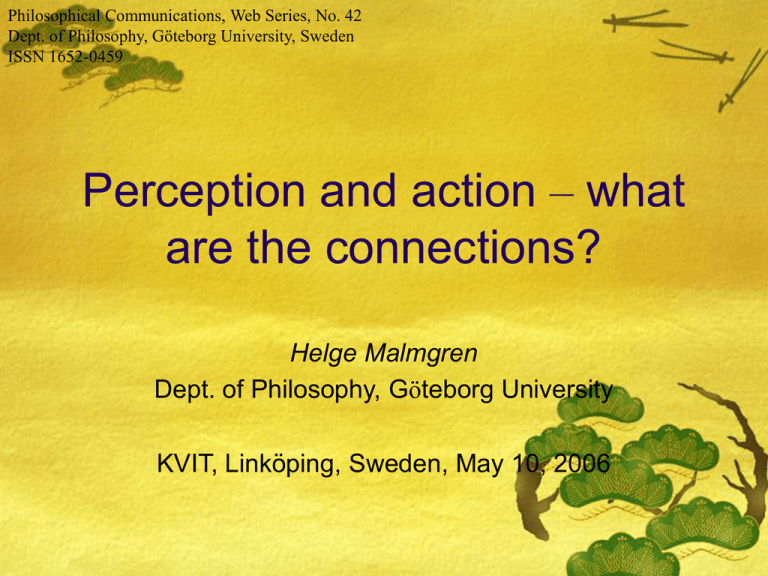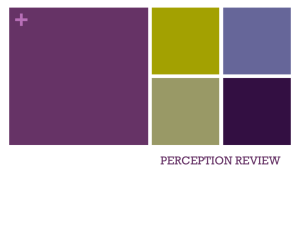perceive our own actions
advertisement

Philosophical Communications, Web Series, No. 42 Dept. of Philosophy, Göteborg University, Sweden ISSN 1652-0459 Perception and action – what are the connections? Helge Malmgren Dept. of Philosophy, Göteborg University KVIT, Linköping, Sweden, May 10, 2006 The seven basic ways Perceiving is acting We perceive in order to act What we perceive is first and foremost action possibilities (affordances) Perception often leads directly to action Perception often results in implicit, procedural knowledge We more or less continually perceive our own actions (in a very special way) We intermittently perceive other people’s actions (in a very special way) KVIT, May 10, 2006 Perceiving is acting ”See” vs ”look” (etcetera) ”Observation” – as result, but also as a process: We move ourselves We move and adjust our sensory organs We use instruments We manipulate the object (not only spatially) We attend to selected objects and features KVIT, May 10, 2006 Attending and acting – what are the connections? Active attention is under voluntary control When voluntary, it requires an effort Attention manifests itself in behaviour Attention is required for motor learning and “automatization” (Attending is learning!) KVIT, May 10, 2006 We perceive in order to act In order to identify the what/where of objects To continually monitor the results of our actions To steer our actions Evolutionary role... ...the reflex hierarchy... ... and conscious aims. (Blindsight) When the body is faster than the mind KVIT, May 10, 2006 Steering and control of behaviour Ballistic and pre-programmed movements: no feedback Simple feedback control: error signal after the action Feedback afterwards is often too slow (you are already dead)... Knowledge about the system’s dynamics enables estimation of the error in advance, and hence control through antecipatory feedback With complete knowledge, external feedback becomes redundant. You may use a copy of the command instead. If you don’t preprogramm... All forward control mechanisms can in turn be controlled by feedback after the event – learned control Start Goal Result d ∆ Start Goal Knowledge Start E(d) ∆ Check Goal E(d) Memory ∆ Start ∆ Knowledge Start Check E(d) ∆ Goal Result d Goal Watching our own performance External perception (including tactile) Internal perception: proprioception (joints, muscles) (overrated?) No feedback but a copy of the command: corollary discharge, efference copy Fast and learnable! KVIT, May 10, 2006 Uses (and abuses?) of the efference copy “Correction” of sensory signals affected by the movement (Helmholz) Forward control of the movement itself? Underlies our sense of agency? Constitutes most of the body schema (in adults)? Defective functioning in schizophrenia??? KVIT, May 10, 2006 Perceiving the actions of others Epistemology vs. psychology ”Theory of mind” theories Simulation theories Bodily identification (mirror neurons, etc.) Another role for the efference copy: feeling the other’s action in oneself? Imitation vs. joint action: cooperation & competition KVIT, May 10, 2006 Seeing movement – even in still pictures Johansson’s lights Seeing a movement as human depends only on its gross features (M. Schiffrer) Global features determine ”movement responses” in the Rorschach test Rorschach also noted a latent imitation in this connection Two ways of perceiving movement: from the outside, and from the inside Physiognomic perception KVIT, May 10, 2006 Perceiving action possibilities To eat, or to be eaten, that is the question The reflex hierarchy Content vs form: embodied knowledge Practical perception Space perception involves the practical perceiving of possible movements Time perception involves practically perceiving the proper timing of actions KVIT, May 10, 2006 The arch-empiricist states... ...I believe whoever will look narrowly into his own thoughts, and examine what he means by saying he sees this or that thing at a distance, will agree with me, that what he sees only suggests to his understanding that, after having passed at a certain distance, to be measured by the motion of his body, which is perceivable by touch, he shall come to perceive such and such tangible ideas, which have been usually connected with such and such visible ideas. (Berkeley, G., An Essay towards a New Theory of Vision) Or, in the language of practical perception: Space is but a system of spatial affordances, organized through the body schema KVIT, May 10, 2006 Time and the body schema Husserl’s idea of time perception: impression, retention, and antecipation of next impression But: Our perception of time is to a large extent a practical perception of the proper timing of actions It is not only important to strike where the ball is, but also when it is there. (The ”when” system?) Complete practical knowledge about the required timing entails an ability to pre-program the action And that is what perceptual learning is for... Start Goal KVIT, May 10, 2006 Overarching issues What are the philosophical implications of the connections between action and perception? Most importantly: Are these connections incompatible with a view of perception as an inferential process? Do they entail that perception is, in any interesting sense, direct? Do they entail that perception does not involve mental representation? So, things may not be so simple after all... KVIT, May 10, 2006






